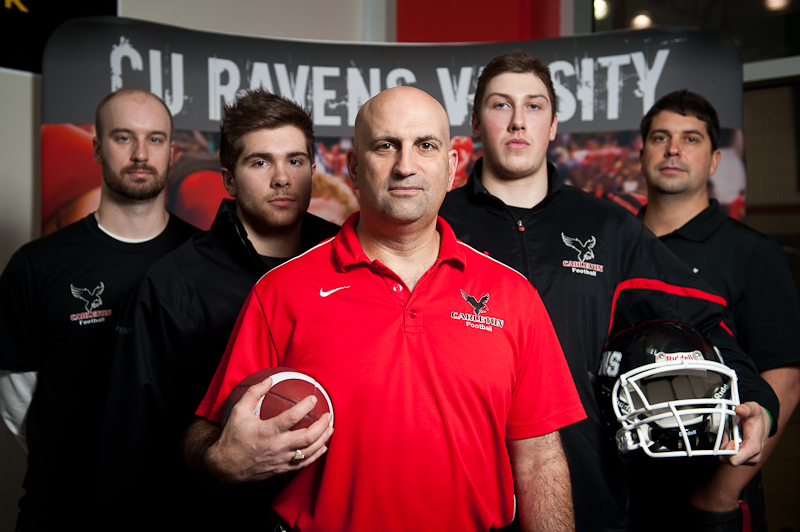It’s a few minutes past midnight on a cold January night in London, Ont. and Carleton Ravens football head coach Steve Sumarah is just leaving the home of a potential recruit.
Sumarah will get to bed soon after a long day of recruiting, but he’ll be right back at it bright and early the next morning.
In fact, he’ll meet with 10 families over a two-and-a-half day period with the hopes of convincing some of the nation’s best up-and-coming football players to become Ravens.
“It’s a non-stop thing,” Sumarah says. “It truly is.”
Keeping busy
Although the Ravens are months away from playing their first game, Sumarah is the busiest he’ll ever be. As the team’s head coach, Sumarah has been tasked with building the expansion Ravens from the ground up and (not surprisingly) it’s been an exhaustive process.
“Coaching is the easy part; the actual recruiting is the biggest part of the job,” Sumarah says. “And once it’s done for the year, it starts for the next one. We’re already talking about our 2014 recruiting. You think you’re ahead, but you’re not.”
With such a high turnover rate on university rosters and the absence of a draft, unlike other sports leagues, effective recruiting is one of the best — if not only — tools coaches can use to consistently field competitive teams.
Every year, coaches spend countless hours scouring the country for potential talent.
Whether scribbling notes on the sidelines during high school games, answering tough questions from parents, or bringing in families for campus visits, there’s always something to do, and never enough time.
Filling out the roster
On average, a Canadian Interuniversity Sport (CIS) football team adds between 30 and 40 new recruits on a yearly basis, which can be a challenge in itself.
Sumarah says he hopes to have a 70-man roster — which would be a smaller roster by CIS standards — in place by September. In subsequent years, the plan is to keep the number of new recruits relatively low.
“We want to make sure we’ve done a good job of keeping guys in school and keeping guys motivated,” Sumarah says. “If we do the job right and take care of the guys that are here, then 20-25 should be a normal recruiting class.”
Over the last year, Sumarah estimates he and his coaching staff would have spoken to at least 500 potential recruits. And that’s a conservative estimate.
Sumarah started recruiting almost from the moment he was hired last January, but more recently he’s had help, particularly from defensive co-ordinator Ryan Bechmanis and offensive co-ordinator J.P. Asselin.
“That’s definitely how we’ve spent most of our time,” says Asselin. “We need to make sure we’re not missing anybody.”
Step-by-step
The first step of recruiting, according to Sumarah, is simply going out and watching football games. That’s usually the first point of contact with any potential recruit, but it wouldn’t involve much more than a casual conversation and an exchange of contact information, he says.
If the Ravens’ coaching staff decides the athlete is worth pursuing, they will follow up and ask that he fill out a recruiting information sheet. These are all stored in a master recruiting database, which is updated regularly.
“From there, you start the phone calls, the emails, the texting and all that kind of stuff to see what their interest is,” Sumarah says.
Many CIS teams, including Carleton, have also started using Facebook accounts to keep in touch with recruits. It’s almost impossible to spend a few minutes in Carleton’s makeshift football offices without hearing the chat notification sound off one of the coaches’ computers.
Queen’s is another team that has their own account. It’s simply a sign of the times, Gaels head coach Pat Sheahan says.
“That’s where the kids are. Electronic messaging is how this generation communicates,” Sheahan says. “If you’re not with the flow of it I think you’re missing a tremendous opportunity.”
If it’s determined there is a mutual interest, Sumarah says the next step would probably be to go watch them play again. Then comes a home visit, a campus visit, and potentially another home visit.
“You could be contacting someone up to 35 times to recruit one kid,” Sumarah says.
Letters-of-intent
As of Feb. 25, 54 athletes had signed letters-of-intent to join Carleton’s football program, according to the CIS letter of intent registry (though the actual number of players to have made some form of commitment is closer to 60).
Letters-of-intent aren’t mandatory, but more and more athletes are becoming keen on signing them and that’s music to Sumarah’s ears. Once an athlete has signed a letter-of-intent, other coaches are no longer permitted to recruit them.
“That’s the part we like the best . . . now they’re our guys,” Sumarah says. “Someone said to me we’ve changed the face of recruiting because we’ve gone out and signed guys early and that’s really sped up the whole recruiting class right across the country.”
There’s no doubt letters-of-intent — and Sumarah and his staff’s charisma— have helped the Ravens’ recruiting efforts, but ultimately, it comes down to the opportunity of joining a first-year program.
At more established programs like Western and McMaster, it’s unlikely first-year players would see much, if any, playing time in their first few years. At Carleton, they could be starters right off the bat.
Playing time is part of the pitch, but Sumarah says it’s also about starting a new tradition of Carleton Ravens football.
“The reality is . . . that’s what we have to offer,” he says. “Everybody coming into this program has an opportunity to be first and that’s a big selling feature. We always joke around in the office and say, if you’re not first . . . you’re last.”






